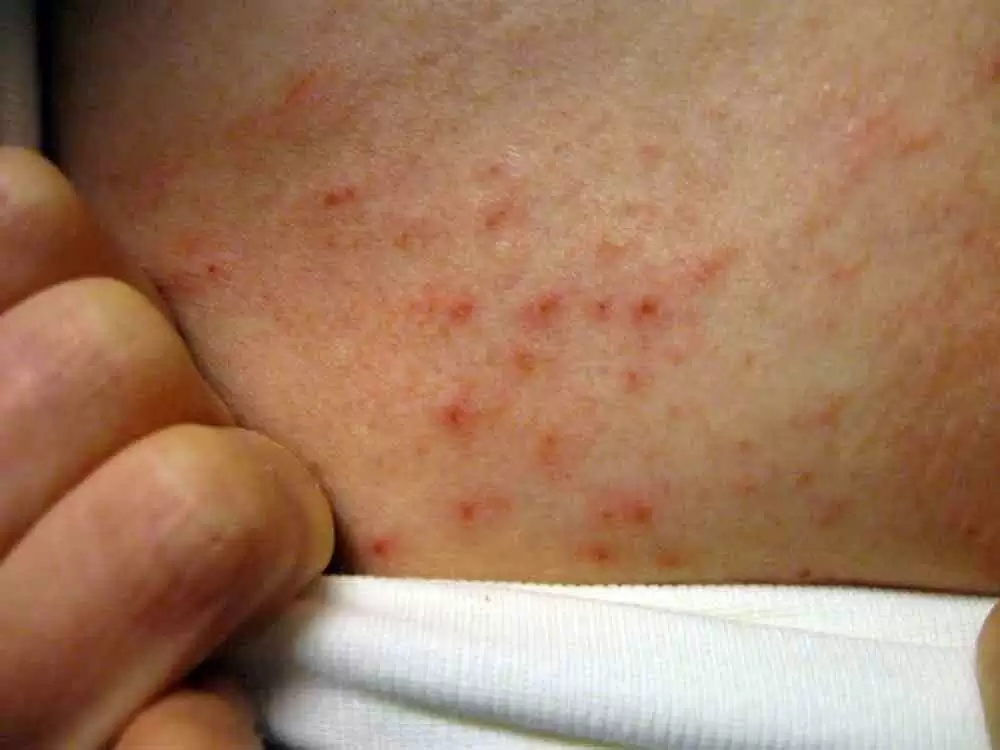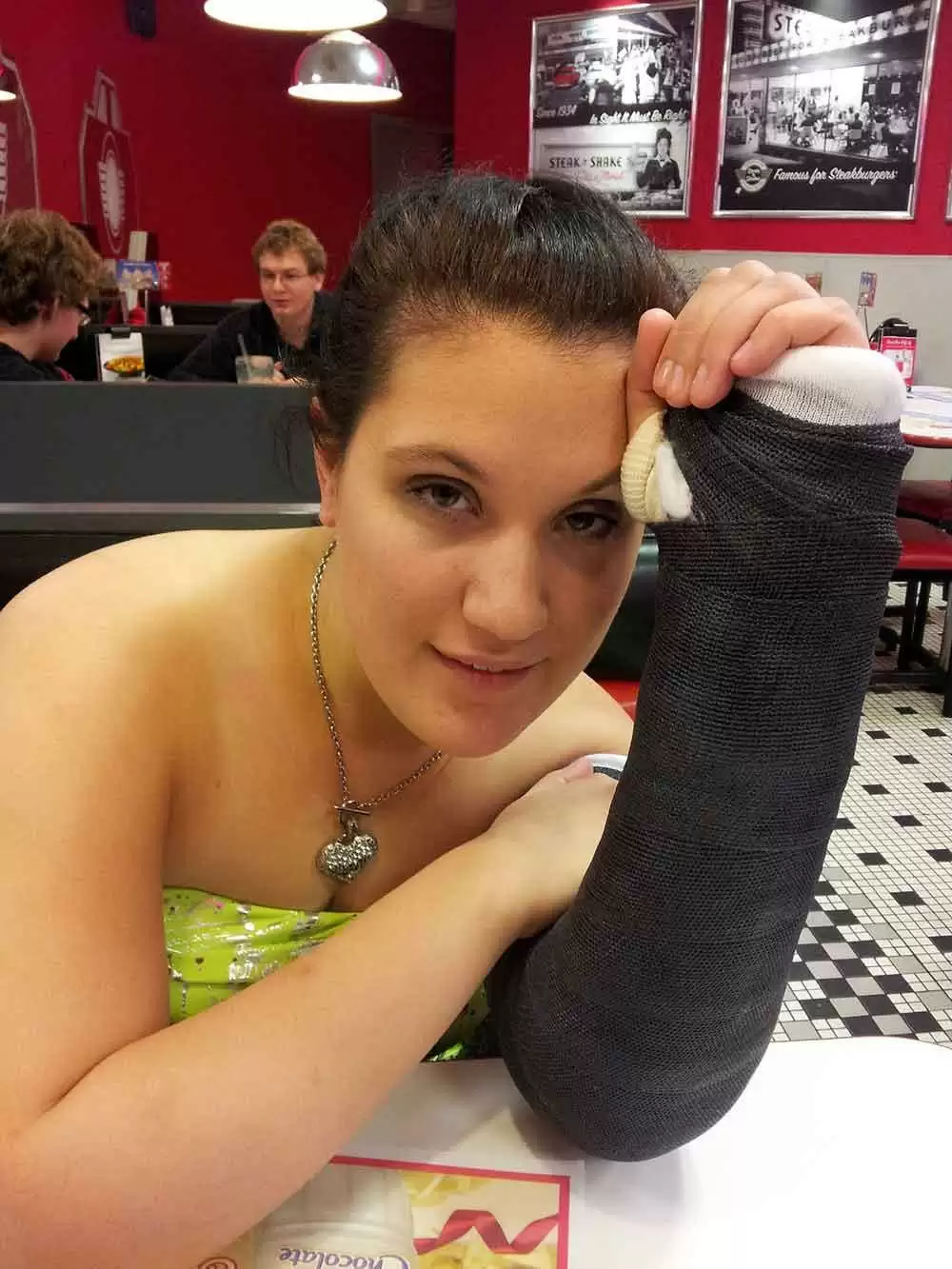
Celiac.com 08/03/2019 (originally published 07/12/2010) - My daughter’s voice revealed her repugnance as she pointed to my legs. “Mom, you have those ugly, red spots on your legs again! What are those things? Why do you get them?”
I sighed and looked down. Once again, the familiar vacation pattern was emerging. After two or three days of hot weather and lots of walking on hard surfaces, little pinhead sized red spots would start appearing on my lower legs. The spots would increase in number and in size until my legs seemed to be a giant blood blister. I had no answer to my daughter’s questions.
Celiac.com Sponsor (A12):
After the previous vacation, I had taken a picture of my legs and later shown it to my doctor, but he only shrugged his shoulders, stating that my guess was as good as his. Actually, I did have a theory. Most vacations also caused pain throughout my entire body. Many nights I lay awake with tears running down my face after everyone else was asleep. Just turning in bed made me groan. The only place that didn’t hurt was a nine-inch square area on my chest. However, I desperately tried to hide my health woes from my family. I took 10-12 aspirins each day to mask the pain. My theory for the purple dots was that I had thinned my blood so much from taking so much aspirin that blood was seeping from my capillaries.
Even after I was diagnosed with celiac disease eight years ago, my theory did not change. After embracing a gluten-free lifestyle, the ugly spots stopped marring my legs while on vacation. At that time I rationalized that my prior vacation diet consisting primarily of gluten-rich food such as sandwiches, pizza, cakes and cookies had caused the intense pain, so my self-diagnosis of aspirin poisoning still seemed appropriate.
Recently, however, my now-grown daughter and I sat in front of my computer, doing a Google search to try to determine what was causing some bumps on her scalp. As we clicked on one of the links, a photo popped up, and both of us instantly pointed at the screen. I gasped, “That’s just what I used to have!” at the same time that she was saying, “Mom, I remember when your legs looked like that!” We had accidentally located a site describing purpura.
As it turns out, if I had ever gone to a doctor when the red bumps were obviously covering my legs, he would probably have diagnosed me with ITP, Idiopathic Thrombocytopenic Purpura, which is characterized by a low platelet count, normally functioning bone marrow, and the absence of a diagnosis of a disorder that would cause loss of platelets. If they had known that I had celiac disease, the diagnosis would have been Secondary TTP, Thrombotic Thrombocytopenic Purpura, because there is evidence that gluten is a trigger for this condition. (Refer to Dr. Ron Hoggan’s article, Thrombocytopenic Purpura and Celiac Disease, published on 7-26-1996.)
The really surprising result of my internet search was the implication that the intense pain I felt during vacations might not have been solely the systemic result of ingesting gluten. Purpura can also cause bleeding in the internal organs. I was aware that there were times when I would have blood in my feces, but I had no way of knowing if other organs or muscles were affected. If the high levels of gluten were indeed causing internal bleeding, I am extremely fortunate that I never experienced a hospitalization as this condition can be acute or even fatal.
Perhaps you are wondering why I did not seek immediate medical attention when my legs were covered with horrible red bumps, there was blood in my stools, and I was suffering constant pain. The answer is simple: I did not trust doctors to be able to find out what was wrong with me. A lifetime of bad experiences had taught me to go to the doctor only for “normal” ailments such as respiratory infections or a sprained ankle, but to leave out any mention of the myriad of “invisible” ailments that I had experienced since childhood. Only when a particular problem was causing a major life-style interruption did I dare to broach the subject with a physician, and then only in a limited manner. Fortunately for me, I had developed a very high pain tolerance and a very positive attitude toward enjoying life in spite of any physical limitations, so I was able to get by pretty well until a perfect storm of circumstances brought me down.
Unlike many people with celiac disease, symptoms during my early years were primarily systemic rather than gastrointestinal. It is only now, with hindsight perspective that these seemingly unrelated symptoms connect to indicate gluten sensitivity. The earliest reaction I can recall occurred around age three when I would often think that cows or soldiers would be coming across the field to storm my grandparent’s farmhouse. At the time, my family thought I was having nightmares because my parents had recently divorced, and I lived half of each week at the farm with my father and the other half of the week in town with my mother’s family. Now I realize that the high-gluten diet at the farm was causing heart palpitations and pounding in my ears, a real sound that only a child would interpret as the sound of invaders. By elementary school, I was often teased for preferring to read rather than run and play with other children. Now I know that the reason I would become so fatigued and nauseated from the heat was a direct result of gluten poisoning.
Being heat intolerant was actually a major problem until my diagnosis. My parents often thought I was just being lazy and that I complained about feeling badly to get out of doing outside chores. At summer camps, I became very creative at avoiding participation in any activity done in full sunlight. My friends loved to lie in the sun, but I wondered why they thought it was so pleasant. It never occurred to me that the pounding headache, the nausea, and the feeling that my heart was going to explode was something that only I experienced. After I married a very adventurous man, summers included active vacations. It usually took at least three months to recover fully from just one week’s holiday.
My gastric symptoms worsened in my teens, and flared up seriously from time to time. At least once a week I would spend an hour in the bathroom, moaning with the pain of what I now know is a spastic colon. Those episodes would leave me so weak that I would have to go to bed afterwards. Finally, I started to realize that something was very wrong with me and began to voice my complaints. At seventeen, I was hospitalized for three days for extensive and often painful testing. The doctor did note that I had the colon of a sixty year old, but still concluded that there was no reason to be concerned because I was just a typical, emotional teenager of the 70’s whose angst was causing a few stomach problems.
It is difficult to describe what that diagnosis did to me. The pains I felt were invisible to everyone else, and apparently even to the medical testing procedures. My doctor and parents thought that I was inventing all this just to get attention. The fear of being labeled a hypochondriac was greater than my fear of the pain. It seemed that my only recourse was to just learn to live with it, whatever “it” was.
Over the next twenty years, I experienced a wide variety of symptoms but I never considered that they could somehow be connected. (For a full list of symptoms, see the box below.) Applying some strategies from Psychology classes and church led to the development of some great coping skills. By focusing on the needs of my husband and children, I could turn down the volume of my body’s cries for attention. By emphasizing the joys of life, I could overlook the minor pains. By visualizing the acute pain as riding a white-water river, I could choose to relax and let the pain “float” me to the next place of calm water. Using a daily session of Bible reading and writing in my prayer journal was my therapy to overcome depression. The natural vitality of youth carried me through those years in what I optimistically considered to be reasonably good health.
However, early-onset menopause started in my late thirties. With it began a rapid downward spiral in my health. Those natural hormonal imbalances seemed to corrode the fragile façade that covered my infirmities. At the same time, the pace of our lives accelerated from busy to chaotic as we entered into our teenagers’ world of sports, school clubs, and endless other social, community and church activities. During those years my energy was sapped with what I sardonically referred to as “terminal fatigue.” The straw that broke the camel’s back was our decision to purchase a custom built house. Along with the understandable stress of learning the ABC’s of home construction while orchestrating the lives of busy teenagers, I also chose to faux finish most of the rooms in our new house. During the cold months of January and February in 2002, I spent at least 30 hours each week mixing and applying paint in unventilated rooms. The central heat was not yet operational, so the professional painters used a smelly, forced- air, propane heater. Because I was so pressed for time, most of our meals were sandwiches from fast food restaurants. As soon as the painting was complete, we made the exhausting move into our new home in mid-March.
It immediately became apparent that my health problems were reaching a critical level. Even after the unpacking was completed, each day I still had to lie down every few hours. Continuing to substitute teach two or three times a week, I was so completely drained at the end of school that I had to lie down for the rest of the day. By now I was an expert at hiding my illness from most people by clever tricks of body language. If my legs felt too leaden to keep up the pace a friend was walking, I could stop to point out some “important” thing that caught my eye so I could rest a bit. I practiced lifting my sagging shoulders and smiling a hello when people came my way. Those tricks could not deceive my family, though. My mother and husband both feared I was dying.
One particularly bad day, I dragged myself out to my nurse practitioner, who was also a family friend, and said, “Jack, check to see if this is diabetes. If it is not, don’t worry about it; no one will ever figure out what this is.” That statement was like waving a red flag in front of a bull, and Jack replied, “No, Jane. We WILL find out what is going on here!”
The initial series of tests seemed to indicate that I had Lupus, even though the lab tests had borderline values. I have since learned that many of the symptoms of systemic celiac disease are very similar to SLE.
Then we discovered that my thyroid was under performing even though the lab tests were within normal limits. According to Broda O. Barnes, MD, PhD, lab tests aren’t sensitive enough to determine low-thyroid function when the hypothyroidism is secondary to a primary illness. A reliable do-it-yourself test is the Barnes Basal Temperature Test. Place a thermometer on the bedside table and immediately upon wakening take your armpit temperature. It is very important to not sit up or move much. If the temperature is 97.8 to 98.2 F, the thyroid is functioning normally. Even a fraction of a degree lower indicates low thyroid function. I took my temperature two days in a row and it averaged 95.3 F! Within five days of starting thyroid meds, I felt significantly less tired.
The next stop was a visit to a neurologist to evaluate leadenness in my legs that made walking difficult as well as the intermittent numbness and tingling in my feet and hands and sometimes across my right cheek. As soon as I described my symptoms, the neurologist shook his head and scowled, “That cannot happen. At whatever place on the spinal column that there is a problem, the numbness would be consistent below that point. There cannot be numbness in random places like that.”
Those words were like a slap across my face! Again, a doctor would rather believe that I made up an impossible set of symptoms rather than look for a way to solve the mystery. In typical fashion, I didn’t argue with him. I just shut down. He completed his exam and his tests but I already knew it was an exercise in futility. Now, after years of being on a gluten free diet, I realize that the neuropathy is somehow a result of the spastic colon. After a lifetime of suppressing the discomfort, I literally no longer feel abdominal pain when the colon is in spasms until it reaches a high enough level that I will suddenly collapse from the shooting pain. The intensity of the spasms is in direct proportion to the area of the neuropathy; toes and finger involvement indicate mild spasms whereas numbness across the cheek, below the elbow and below the knees means things are getting bad. The size of my bowel movements always confirms the neuropathy diagnosis of the intensity of the spasms. [Note: Nutrasweet Artificial Sweetener also triggers the neuropathy.]
The next specialist was a gastroenterologist who diagnosed the celiac disease. I had presented to him only the symptoms of blood in my feces and dumping diarrhea, fearing that disclosing any more symptoms would label me again as a hypochondriac. When the doctor was explaining the results of my colonoscopy, he commented that I had an extremely spastic colon. Jerking my head around, I snapped, “How did you know? I did not tell you that!” He looked very confused that I would not have told him about such an important symptom, but even then I could not bring myself to trust him with more information. This month, because I am now virtually symptom free, I finally found the courage to present him the list of previous symptoms with an explanation for why I had withheld important diagnostic facts. He looked shocked at the sheer number of symptoms, which made me glad I could report that I was now substantially symptom free.
I take some comfort from knowing that my experience has been instructive to my doctors and will perhaps make the journey easier for others who have undiagnosed celiac disease. The life-style change was difficult, and for a year I grieved the loss of my favorite foods as if a close friend had died. But the results are astounding! Now that I have been gluten free for several years, my children marvel at the change in my energy level. Last summer, our family had a July vacation to Texas during a heat wave where the temperature soared to 112 degrees one day, yet I never missed one activity and felt well at the end of the trip. While we were playing miniature golf one afternoon, I looked up to see my daughters smiling broadly at me, and they exclaimed, “Wow, Mom! Look at you!”
Although I am now 55-years-old, I look and feel younger than I did twenty years ago. Because of the benefits of a gluten-free diet, along with the discovery of Z-coil shoes for problems with my feet, I am like a new woman! Out of my 70+ previous ailments, I now only have the allergies and those mild, easily manageable symptoms related to the hiatal hernia, tinnitus, and Sjogren-like dryness (these last three are linked to celiac disease and might not be a problem if I had been diagnosed earlier).
Recently, I was carrying a 19-inch TV down the stairs, and my younger daughter rushed to help me with the load. When I cheerfully declined her help, she stepped back and declared, “Who are you, and what have you done with my Mom?” May all who embrace the gluten-free life-style have such spectacular results!
Summary of All Previous Health Problems:
- Abdominal Pain
- Acid Reflux
- Allergies (seasonal, mold, chemicals)
- Alpha-1, Anti-Trypsin Deficiency
- Anemia
- Arthritis/Joint Pain
- Bladder/Kidneys Infections and Pain
- Blood in Feces
- Bloating
- Brittle Nails
- Colon Polyps
- Cystocele
- Depression
- Diarrhea/Constipation Cycles
- Dry Eyes
- Dry Mouth
- Dry Nasal Passages
- Dry Vagina
- Dumping Diarrhea
- Ectopic Pregnancies (2)
- Extreme fatigue
- Eye Pain, right side with migraines
- Eye Sensitivity to Make-up and Lotions
- Face Aches
- Facial Rash (similar to lupus rash)
- Feet/Ankle Swelling
- Fibrocystic Breasts
- Foot Pain
- Frequent Headaches
- Frozen Shoulder
- General Malaise
- Generalized Weakness
- Gout
- Hair Loss
- Heart Palpitations
- Heat intoleranc
- Hiatal Hernia
- Hoarseness
- Hypoglycemia
- Hypothyroidism
- Hysterectomy
- Infertility Problems
- Insomnia
- Irritable Bowel Syndrome/Spastic Colon
- Lack of Concentration
- Legs Buckle
- Low Grade Fever
- Lung Congestion
- Memory Impairment
- Mental Confusion
- Mid-Back Pain
- Migraines, Primarily Right Side
- Mouth Ulcers
- Muscle Weakness
- Muscles Spasms in Back
- Nasal Congestion
- Nausea in Varying Degrees
- Neck Stiffness
- Neuropathy in Feet and Hands
- Night Sweats (non-menopause)
- Numbness and Tingling
- Occasional Asthma
- Plantar Fasciitis
- Puffiness/Fluid Retention
- Purpura
- Rectocele
- Right Cheek Numbness and Tingling
- Shortness of Breath
- Sore Tongue
- Stomach Pain
- Stomach Polyps
- Tinnitus
- TMJ – Temporomandibular Joint Pain
- Vaginal Discharges/Yeast Infections
- Various Localized Pains
- Weight Gain
- White Coating on Tongue











Recommended Comments
Create an account or sign in to comment
You need to be a member in order to leave a comment
Create an account
Sign up for a new account in our community. It's easy!
Register a new accountSign in
Already have an account? Sign in here.
Sign In Now